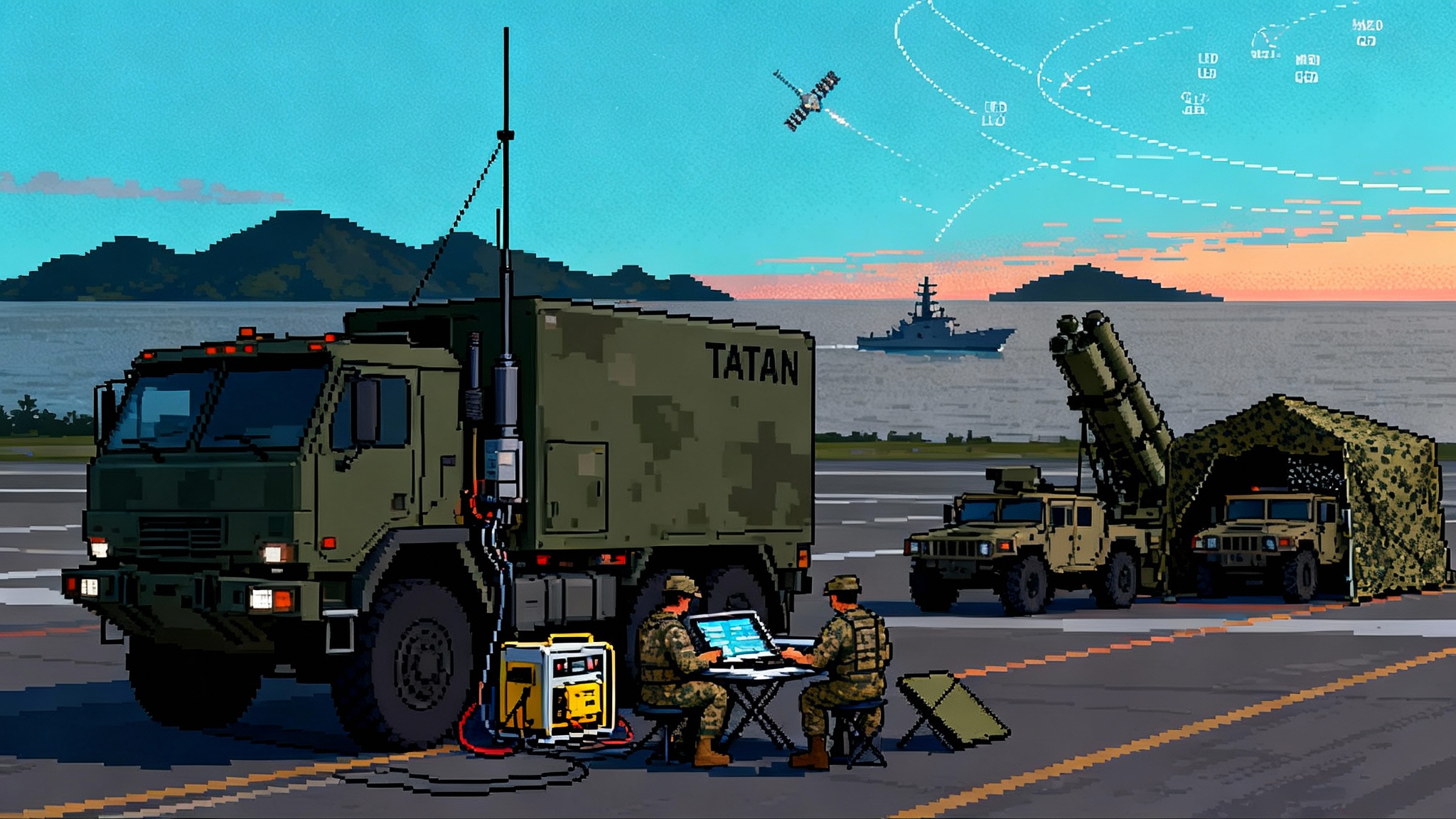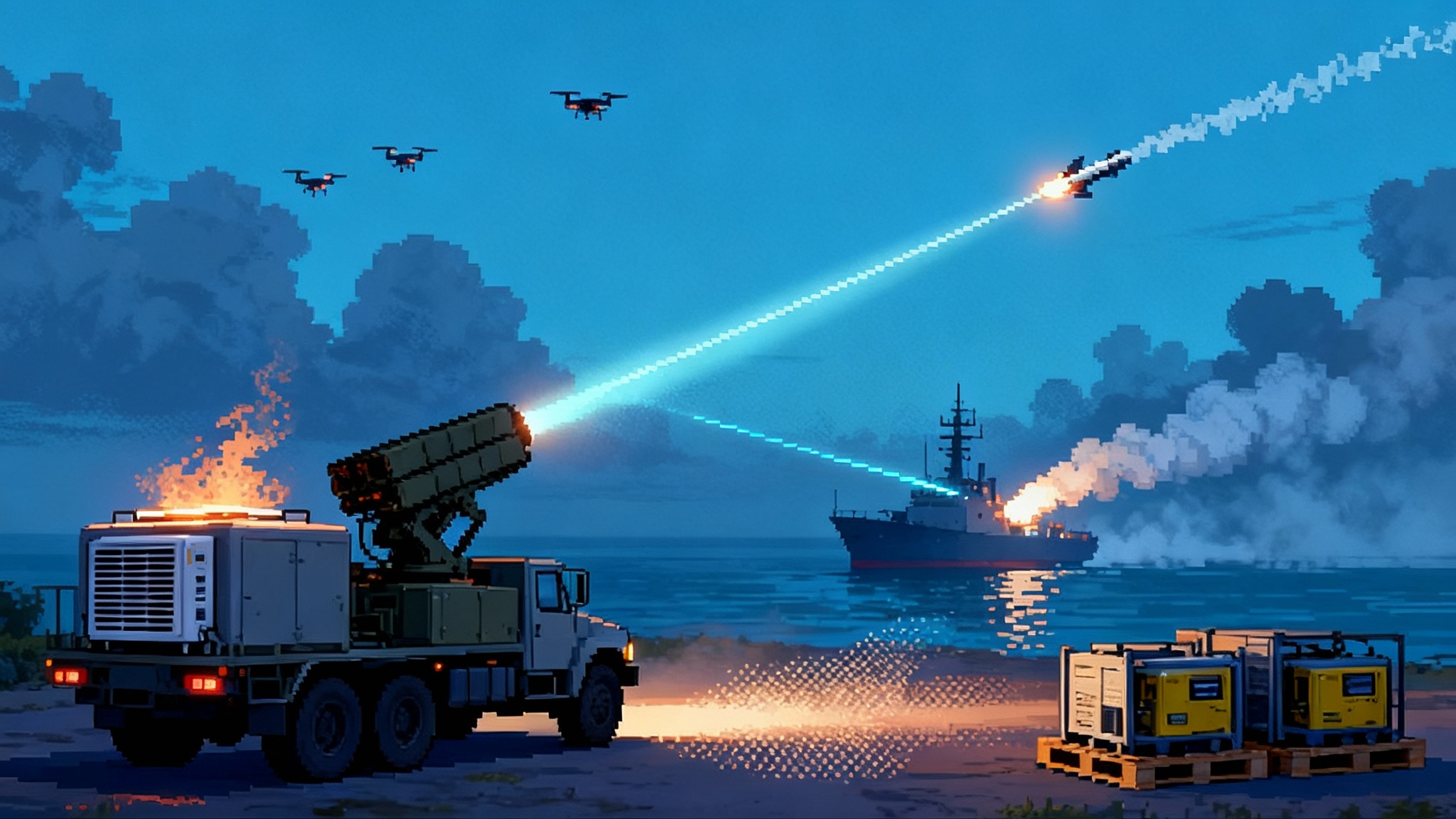Microwaves vs the Swarm: HPM Weapons Move to Fielding
In August 2025 a truck-mounted high-power microwave erased 61 drones in seconds. Solid-state arrays, battery power and FAAD C2 integration are flipping the counter-drone cost curve from missiles to energy shots.

The moment the math flips
In late August 2025, a high-power microwave truck rolled onto a test range at Camp Atterbury, Indiana. Minutes later, a cloud of quadcopters fell like cut marionettes. In that single sequence, a Leonidas system neutralized 61 of 61 drones, including a 49-drone volley with one pulse. The demonstration was staged, but the effect was real, and it marked a turning point. If one energy shot can erase dozens of low-cost aerial threats, the economics of counter-drone defense change. That is why, after a year of live-fire trials and early Marine Corps adoption steps, the discussion has shifted from if to how fast these weapons can be fielded. See the 61-drone live-fire trial at Camp Atterbury.
High-power microwave, or HPM, is not new, but two things are: the tactical maturity of solid-state systems and the urgency created by mass first-person-view drone attacks. In 2025 the U.S. Marine Corps received an expeditionary HPM prototype for evaluation, while the U.S. Army advanced its Indirect Fire Protection Capability high-power microwave variant, adding range, power and soldier-driven usability. Put simply, 2025 proved HPM could crush swarms at operational ranges and do it with a shot cost that looks like electricity rather than missiles.
How HPM works without the jargon
Think of HPM as a camera flash made enormous and precise. Instead of light, it emits a brief, intense microwave pulse, shaped by software and aimed by antennas. Any drone in the beam’s footprint is bathed in energy. The surge couples into the drone’s electronics through antennas, wires and seams, causing processors and control links to glitch or crash. Because the pulse blankets an area, HPM can disable many drones at once. That is the one-to-many advantage that lasers and bullets lack.
Modern systems are built from gallium nitride power amplifiers rather than big vacuum tubes. Gallium nitride lets you stack lots of small solid-state modules into a scalable array, like adding more speakers to get louder sound. No warmup, no fragile glass tubes, far less maintenance. The result is a compact effector that can ride on a tactical truck, a trailer or even a robotic vehicle.
The cost math that breaks the swarm
Swarms are designed to win by economics. If defenders must spend one missile per drone, and the attacker can flood the sky with hundreds of cheap airframes and off-the-shelf warheads, the defender bleeds money and inventory. HPM flips that script. Instead of one missile for one drone, HPM offers one pulse for many drones. The magazine is limited by fuel and batteries rather than by launch-cell count. The shot cost is energy, not an all-up round.
Imagine a logistics hub facing an incoming wave of 80 small drones guided by cheap radios and preloaded waypoints. With interceptors, even a well-run battery might exhaust missiles before the wave is halved. With HPM, the first salvo is an area pulse that collapses dozens. That changes the rest of the fight. Lasers and guns can clean up. Missiles are conserved for the handful of larger, faster or hardened threats. Commanders can write new shot doctrine that assigns the cheapest effective effector first and keeps the gold-plated rounds for the targets that demand them. For a complementary view on directed-energy economics, see how lasers reshape air-defense economics.
2025: from prototype to platoon playbook
Three concrete developments in 2025 pushed HPM out of the lab and toward fielding:
- Live-fire credibility. Publicly observed trials against large drone sets, with multi-angle shots and selective effects, answered the two big questions: can it scale beyond a single target, and can it avoid friendly casualties on the ground. The answer in both cases was yes, within defined safety gates.
- Marine Corps experimentation. The Corps took delivery of an expeditionary HPM prototype to support Ground Based Air Defense and Low Altitude Air Defense missions. That move put HPM into Marine tactics, techniques and procedures development, where questions about vehicle integration, beachhead defense, and littoral logistics can be answered by Marines rather than by marketing slides.
- Army integration and iteration. The Army’s HPM path under Indirect Fire Protection Capability added a second-generation build focused on range, power and soldier usability, while continuing operational assessments. The signal was clear: the service is not just testing, it is tuning for real employment.
Why FAAD C2 and IFPC integration matters in the real fight
A counter-drone weapon is only as good as the network that tells it what to shoot, when and with what rules. In the Army, that network is the Forward Area Air Defense Command and Control system, or FAAD C2, and the broader Indirect Fire Protection Capability architecture. When an HPM effector is integrated into FAAD C2, it becomes another selectable shooter in the digital kill chain. That means radar tracks, electro-optical sightings, identification rules and restricted-fire zones flow into the same picture that guides missiles and guns. It also means emissions can be authorized or held based on airspace management and fratricide risk, not on the gut feel of a single vehicle commander. This aligns with the trend toward AI-enabled targeting at the edge, as seen in AI target fusion on wheels.
This is not theoretical. FAAD C2 interoperability for HPM was validated during Army testing, which moved HPM from a stand-alone science project to a networked effector that can be cued, deconflicted and recorded like any other air defense asset. See the FAAD C2 interoperability confirmed in Army testing.
Tactically, that integration changes how units maneuver and fight:
- Cueing and prioritization. Sensors push tracks to FAAD C2. The fire direction cell assigns HPM to dense clusters and single-shot effectors to leakers. HPM does not hunt blindly; it is cued to the richest part of the swarm.
- Emission discipline. HPM emissions are powerful. Integration lets commanders set geographic safe zones, protected frequency bands and time windows to avoid harming friendly drones, radios and civilian infrastructure. Software geofences and notch filters enforce these decisions. Units experimenting with spectrum power to platoons will find the practices translate.
- Layered engagement. Within an IFPC battery, HPM becomes the first layer against small drones, with lasers and guns as precision follow-ons and interceptors reserved for cruise missiles and larger uncrewed systems. That sequence preserves expensive magazines and shortens kill chains.
Power and logistics: the boring breakthroughs that made HPM mobile
Older HPM concepts needed truck-sized generators, heavy thermal management and exotic tubes. That made them static, loud and maintenance-hungry. The recent breakthroughs are less cinematic but far more important for warfighters:
- Solid-state gallium nitride amplifiers. These modules scale like building blocks. Add more to increase power or swap out a failed module at the motor pool. No vacuum tubes to baby. No fragile filaments.
- Long-pulse, software-defined waveforms. Instead of a single, brittle spike, modern HPM uses longer pulses and adjustable polarization that couple energy more reliably into consumer-grade electronics. Software updates improve lethality without hardware swaps.
- High-density batteries and hybrid power. New builds include battery packs sized for prolonged silent watch and repeated pulses. Generators still matter for sustained operations, but the system can fight from stored energy, then charge while repositioning. That addresses the old objection that HPM could not keep up with maneuver units.
- Better thermal design. Heat sinks, liquid cooling loops and smart duty cycles mean repeated shots without cooking the array. The system self-monitors and throttles to stay inside safe temperatures.
These are logistics wins as much as engineering wins. Units can tow a trailer or mount the array on a tactical truck and expect it to work after a rough road march. There are still constraints. HPM draws serious power during pulses, and crews must manage emissions, heat and battery state. But the days of purely static microwave fences are over.
Mobility matters: toward unmanned HPM fires
Another shift in 2025 was mobility. Industry pairings put HPM arrays on robotic carriers with hybrid-electric drivetrains and autonomy kits. The concept is simple and attractive: send a remotely operated, magazine-deep effector to sit near a choke point or along a brigade flank while the human crew stays out of the kill box. Onboard sensing, compute and energy storage turn the platform into a self-contained fires node that can be cued by FAAD C2. A wheeled variant can handle road nets and rapid displacement. A tracked variant can crawl into defilade and wait.
This matters for two reasons. First, mobility breaks the attacker’s targeting cycle. If the HPM effector moves between shots, preplanned strikes and decoys become less effective. Second, unmanned operation reduces risk. If an enemy artillery radar homes in on emissions, the crew is not sitting under the antenna.
What commanders can do with HPM today
HPM is not a magic wand. It complements, rather than replaces, the rest of short-range air defense. Used well, it can make everything else work better. Here is how:
- Write a shot doctrine that starts with HPM for massed small drones, then cascades to lasers and guns for singles, and finally to interceptors for hardened or fast flyers. Practice it in force-on-force events, not just on sterile ranges.
- Place HPM to protect key nodes rather than trying to ring the entire area. HPM thrives where queues form: approach lanes, river crossings, ammunition points and command posts. Use mobility to change those queues.
- Pre-plan spectrum rules. Identify friendly frequencies, civilian infrastructure and critical emitters. Set geofences and notch filters before the fight. Put those rules into FAAD C2 so every effector sees the same constraints.
- Train for emissions discipline. HPM makes noise in the electromagnetic spectrum. Treat it like a radio and a weapon at once. Keep logs, rehearse authorization chains and run drills that test fratricide avoidance with friendly drones overhead.
- Pair with the right sensors. Wide-area 3D radars and electro-optical trackers find the clusters that HPM can erase. A cheap radar that builds a dense picture is often more valuable to HPM than a boutique sensor that tracks one target perfectly.
Allies are moving too, and 2026-27 will be a race
Allies are not waiting. The United Kingdom tested a new microwave weapon against swarms in 2025. Indo-Pacific partners watched the U.S. demonstrations closely and are evaluating layered counter-drone packages that include HPM alongside jammers and guns. Venture funding and defense contracts are pushing production capacity, and prime-sub partnerships are compressing integration timelines.
Expect 2026-27 to bring:
- HPM batteries stood up inside U.S. Army air defense battalions and at selected fixed sites under IFPC. Some will be semi-fixed with relocatable power and shelters. Others will be on tactical trucks with quick-erect masts.
- Marine Corps HPM detachments aligned to Low Altitude Air Defense battalions for experimentation in Expeditionary Advanced Base Operations. Early use cases will include beachhead defense, logistics hubs and forward refueling points.
- Air Force and Navy niche deployments for airfield and pier protection where small drones threaten sortie rates and port operations.
- Allied buys tied to joint exercises where HPM is plugged into FAAD C2 or equivalent national systems to prove coalition interoperability.
The practical bottlenecks will be power provisioning, training pipelines and spectrum policy. Batteries solve a lot, but diesel plans still matter for long events. Schools will need to teach emissions discipline, safety arcs and friendly drone integration. Spectrum managers will write rules that balance lethality with civil interference risks. None of that is glamorous, but it determines whether these systems show up as ready units or as science projects.
The tradeoffs to watch
- Collateral electromagnetic effects. The same pulse that topples a drone can upset unshielded electronics nearby. Software geofences and frequency excision reduce risk, but commanders must enforce separation distances and safe-drop zones.
- Adversary adaptation. Expect hardened flight controllers, fiber-optic tethers, and decoy swarms designed to trigger premature shots. HPM will force opponents to spend more on each drone, which is a win, but the cat-and-mouse will continue.
- Weather and clutter. Heavy rain and urban canyons can scatter and absorb energy. Range will vary with conditions. Operators will learn where HPM is a sledgehammer and where it is better as a scalpel.
A concluding lens for 2027
If 2025 was the year HPM proved it could knock down the swarm, 2026-27 will be the years commanders prove they can build units around it. The technology has crossed a threshold: solid-state arrays, high-density batteries and software-defined waveforms are no longer wish lists. Integration with FAAD C2 and IFPC means HPM can be tasked, deconflicted and measured like any other shooter. That is the real breakthrough. Once a weapon joins the network, it stops being a demo and starts being a doctrine. The race is on, and the side that learns to spend energy instead of interceptors to kill drones will buy back time, money and freedom of action on battlefields crowded with robots.








